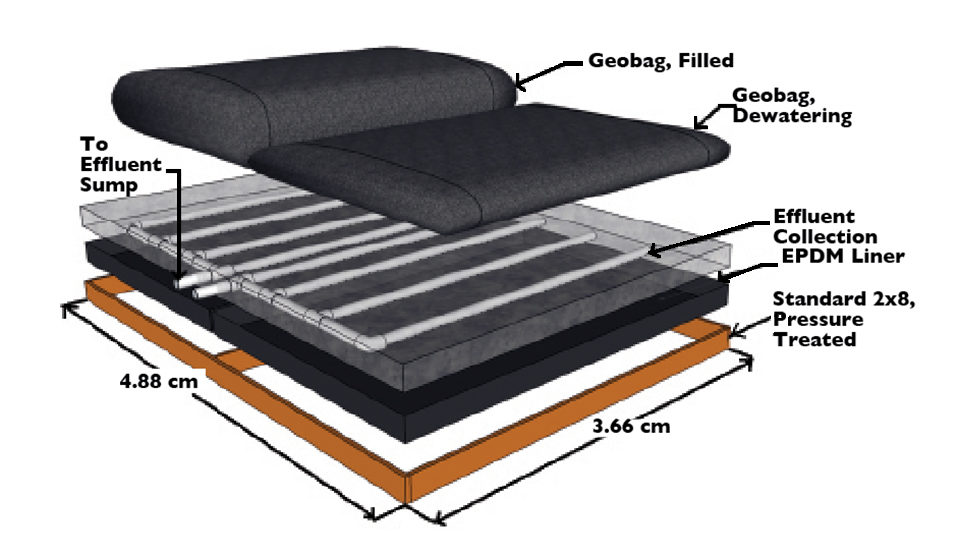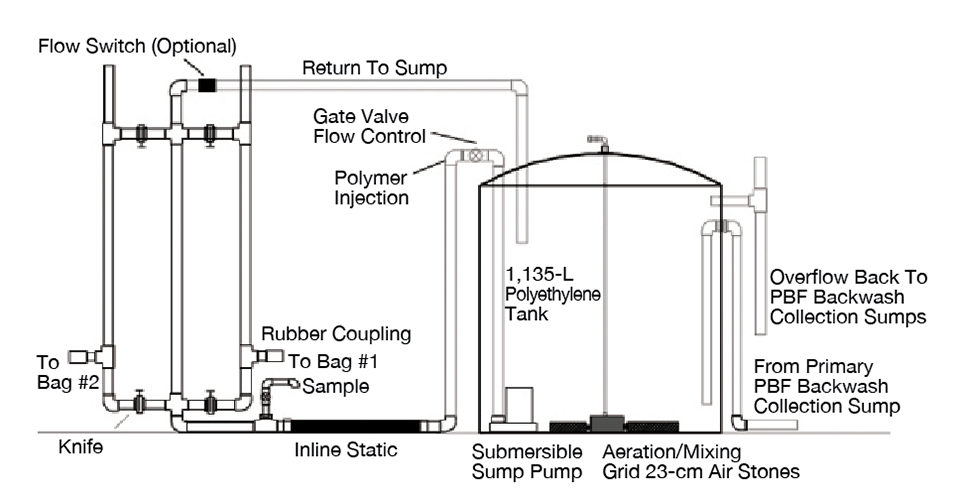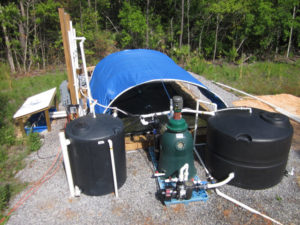Bags can dewater wastes over 10 percent solids per volume in less than a week

Intensive recirculating aquaculture systems (RAS) face a series of challenges that limit productivity. These challenges include tank design, circulation efficiency, solids capture, cost-effective removal of toxic ammonia-nitrogen, carbon dioxide stripping, maintenance of sufficient dissolved oxygen and the ever-increasing demand for higher water quality for marine species.
In addition, the increased carrying capacity in large-scale commercial aquaculture achieved over the last 20 years has generated a new problem: effluent waste management. Over the past several years, environmental discharge regulations for aquaculture have made environmentally sound waste management and disposal increasingly important, particularly for marine aquaculture. Because of their moisture content, management of the solid wastes generated by aquaculture systems presents unique storage and disposal problems.
Mechanical filters such as microscreens, sand filters and floating-bead filters generate solid waste effluent dis-charges that require further concentration to reduce the quantity and improve the quality of the discharges. For marine RAS, it is further critical that a significant percentage of the waste effluent stream be recycled back into the production system to conserve salt and reduce and/or eliminate the environmental impacts of salt discharges.
The development of improved systems for the disposal and reutilization of aquaculture wastes is a critical priority, as enhanced waste management systems will improve the economic viability and sustainability of marine aquaculture systems.
Current technologies
Current technologies for storing and dewatering solid wastes from marine aquaculture are expensive to install, require high maintenance or have poor treatment efficiencies because of geographical location or poor management.
The two most common methods used to recycle solid wastes from aquaculture facilities are composting and land application. Both methods can be enhanced by dewatering the wastes before utilization.
Geotextile bags
One promising new technology for dewatering aquaculture solid waste is the use of geotextile bags. Geotextile bags are porous, sealed tubular containers constructed of high-strength, woven polyethylene material that have demonstrated the ability to dewater terrestrial animal wastes, municipal wastewater sludge and dredge spoil.
Geotextile bags can dewater wastes over 10 percent solids per volume in less than a week and can achieve 30 percent final solids content. Geotextile bags are cost-effective, site-specific and mobile. They require little maintenance and can be custom-sized.
Other than from limited demonstration trials, there is little engineering design information available for using geotextile bags for the treatment of marine aquaculture waste streams, as opposed to the treatment of other industrial sludge.
One of the primary difficulties when designing aquaculture systems is the wide variation in the concentration, composition, salinity, pH, temperature and quantity of wastes, much of which is dependent on the species grown. Even with a “saltwater system,” the actual salinity might vary from as low as 2 to 38 ppt, depending upon the species and growth phase.
Primary treatment
The authors installed a demonstration system in the fall of 2010 to treat the waste discharge from a spotted sea trout, Cynoscion nebulosus, growout facility at the Gulf Coast Research Laboratory of the University of Southern Mississippi.
Working with facility personnel, an estimate was made of the daily volume of backwash from the six propeller-washed bead filters used for solids capture. Based on this estimate, a sludge sump tank was sized to hold a single daily production of sludge for batch loading into the geotextile bag.
The sludge sump tank provided a consistent flow into the geotextile bag, which allowed a dosing pump to add a predetermined concentration of a coagulation and flocculation aid. The geotextile bag was filled from the sludge sump tank up to 85 percent of its volume and allowed to drain and consolidate for three to four hours. This cycle is repeated until the geotextile bag reaches its final capacity of 85 percent consolidated solids.
Maximum pressure on the multiple bags was limited to 1-2 psi by using a standpipe/overflow to direct the flow from the full bag to the next bag in line. The coagulation and flocculation aid was mixed into the waste stream as it entered the geotextile bag from the sludge sump with an inline mixing column.
The geotextile bags were supported on a gravel bed with a liner and drainage pipes to direct the effluent flow into a small recovery sump. From the recovery sump, the geotextile bag effluent was pumped to a supernatant sump for secondary treatment and reuse in the culture system.

Secondary treatment
The secondary treatment system incorporates three aspects of an engineered approach to saltwater reclamation: bioclarification (mechanical/biofiltration), disinfection/sterilization and denitrification. A propeller-washed bead filter was used for bioclarification, an ultraviolet sterilizer was used for disinfection, and an activated carbon filter was used for final polishing and removal of trace organics, metals and other potential pollutants. Capacity for a passive denitrification system designed by Aquaculture Systems Technology, LLC was engineered into the system to provide removal of nitrate-nitrogen.
This suite of secondary treatment equipment constitutes its own recirculating loop to ensure maximum stripping of unwanted solids and nutrients prior to transfer to a reservoir for reintroduction into the culture system.
Performance

The system has been operational for several months, and the first cohort of spotted sea trout has been raised for a stock enhancement program. The system was monitored every two weeks, and water quality samples were taken from the sludge storage tank, geobag supernatant and the treated supernatant reservoir. This trial was without a coagulant or flocculant agent as a control. Initial results showed a slight 8.22 to 8.93 increase in pH across the treatment train.
More importantly, there was a net decrease in ammonia-nitrogen from an initial value of 6.61 mg/L to 0.99 mg/L and a decrease in nitrite-nitrogen from 4.84 to 0.68 mg/L. Additionally, there was a decrease in dissolved orthophosphate from an initial concentration of 31.0 mg/L to 13.1 mg/L phosphate. Moreover, the total suspended-solids concentration was reduced from a sludge value of approximately 1,600 mg/L to less than 2 mg/L, a 99.9 percent removal rate.
Currently, Aquaculture Systems Technologies and Gulf Coast Research Lab are using the results of this trial to design, install and operate a large system to treat all backwash water from the entire lab’s aquaculture facility under the auspices of a grant from the NOAA Sea Grant Aquaculture Research Program.
(Editor’s Note: This article was originally published in the November/December 2011 print edition of the Global Aquaculture Advocate.)
Authors
-
James M. Ebeling, Ph.D.
Research Engineer
Aquaculture Systems Technologies, LLC
108 Industrial Avenue
New Orleans, Louisiana 70121 USA[109,111,99,46,115,114,101,116,108,105,102,100,97,101,98,64,115,101,109,97,106]
-
Paul Hightower
Research Associate
Aquaculture Systems Technologies, LLC
108 Industrial Avenue
New Orleans, Louisiana 70121 USA -
Reginald B. Blaylock, Ph.D.
Associate Research Professor
Gulf Coast Research Laboratory
University of Southern Mississippi
Ocean Springs, Mississippi, USA
Related Posts

Responsibility
Geotextile bag, flocculant technology capture RAS waste
Geotextile bags used in combination with polymer flocculant aid chemicals can provide effective primary treatment of recirculating aquaculture system effluent. Much of the suspended solids that carry the majority of the organic load within the effluent can be captured by these systems.

Responsibility
A look at various intensive shrimp farming systems in Asia
The impact of diseases led some Asian shrimp farming countries to develop biofloc and recirculation aquaculture system (RAS) production technologies. Treating incoming water for culture operations and wastewater treatment are biosecurity measures for disease prevention and control.

Responsibility
Advances in super-intensive, zero-exchange shrimp raceways
Research at the Texas AgriLife Research Mariculture Laboratory is investigating ways to improve the economic viability of super-intensive raceways for shrimp production.

Health & Welfare
Aquamimicry: A revolutionary concept for shrimp farming
Aquamimicry simulates natural, estuarine production conditions by creating zooplankton blooms as supplemental nutrition to the cultured shrimp, and beneficial bacteria to maintain water quality. Better-quality shrimp can be produced at lower cost and in a more sustainable manner.


